“Horst Faas (28 April 1933 – 10 May 2012) was a German photo-journalist and two-time Pulitzer Prize winner. He is best-known for his images of the Vietnam War”. – Wikipedia
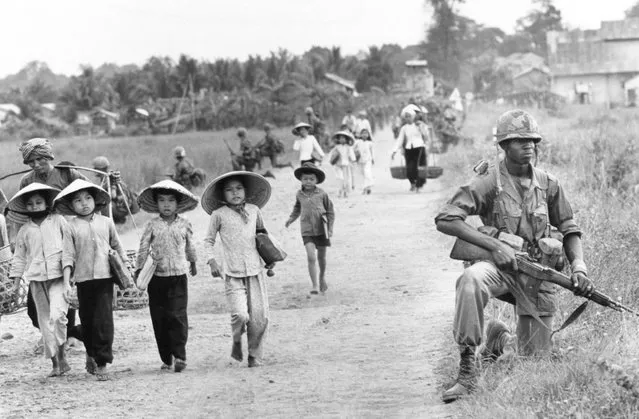
In this December 1965 file photo shot by Associated Press photographer Horst Faas, a U.S. 1st Division soldier guards Route 7 as Vietnamese women and school children return home to the village of Xuan Dien from Ben Cat, Vietnam. (Photo by AP Photo/Horst Faas)
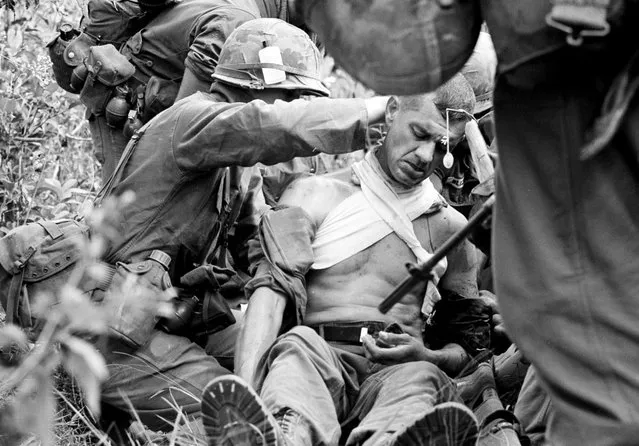
In this Jan. 16, 1966 file photo taken by Associated Press photographer Horst Faas, Lt. Col. George Eyster of Florida is placed on a stretcher after being shot by a Viet Cong sniper at Trung Lap, South Vietnam. (Photo by AP Photo/Horst Faas, File)
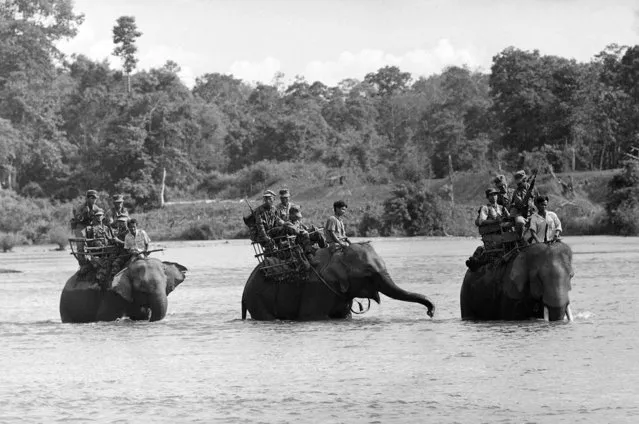
South Vietnamese soldiers ride elephants across a river in the Ba Don area, about 20 miles from the Cambodian border, during a patrol in search of Viet Cong guerrillas in June 1964. In some conditions, the Hannibal-like transportation is more suited to jungle warfare than more modern vehicles. (Photo by AP Photo/Horst Faas)
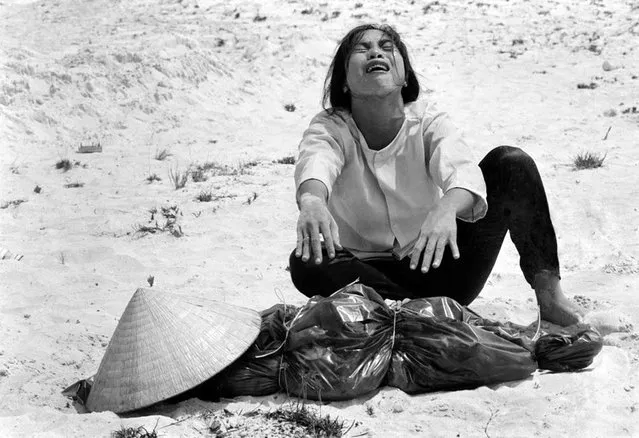
A South Vietnamese woman mourns over the body of her husband, found with 47 others in a mass grave near Hue, Vietnam in April of 1969. (Photo by AP Photo/Horst Faas)
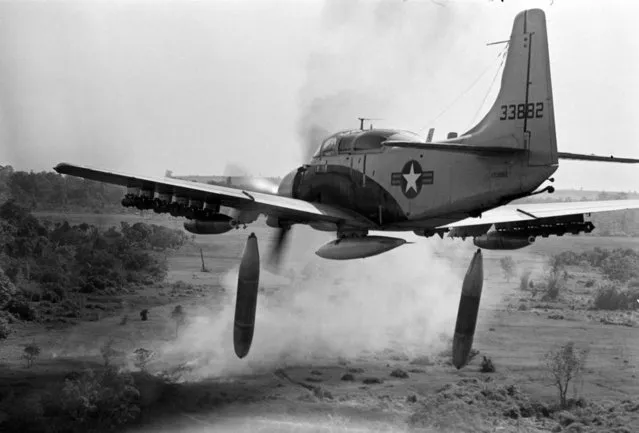
Flying low over the jungle, an A-1 Skyraider drops 500-pound bombs on a Viet Cong position below as smoke rises from a previous pass at the target, Dec. 26, 1964. (Photo by AP Photo/Horst Faas)
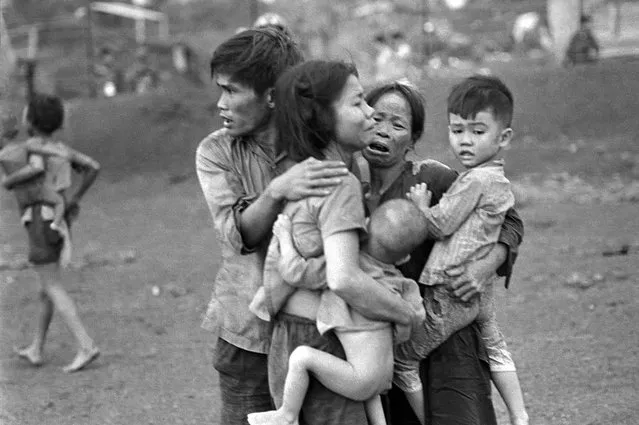
In this June 1965 photo, South Vietnamese civilians, among the few survivors of two days of heavy fighting, huddle together in the aftermath of an attack by government troops to retake the post at Dong Xoai, Vietnam. (Photo by AP Photo/Horst Faas)
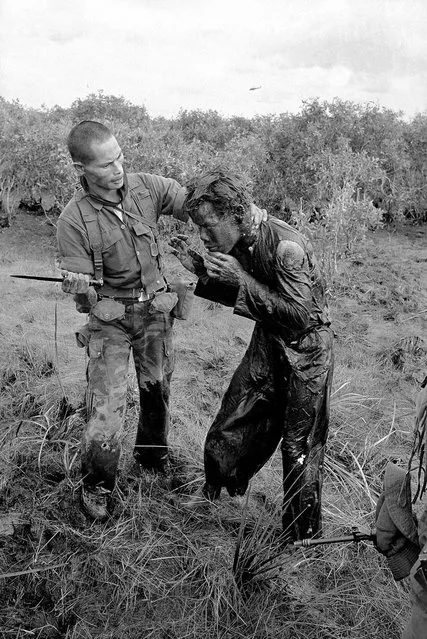
In this Jan. 9, 1964 photo, a South Vietnamese soldier uses the end of a dagger to beat a farmer for allegedly supplying government troops with inaccurate information about the movement of Viet Cong guerrillas in a village west of Saigon, Vietnam. (Photo by AP Photo/Horst Faas)

With a few salvaged belongings in the background, a Vietnamese woman carries a baby and pulls her daughter away as their home erupts in flames in July 1963. The woman and children may have been left behind so as not to slow other villagers escaping into the jungle. (Photo by AP Photo/Horst Faas)
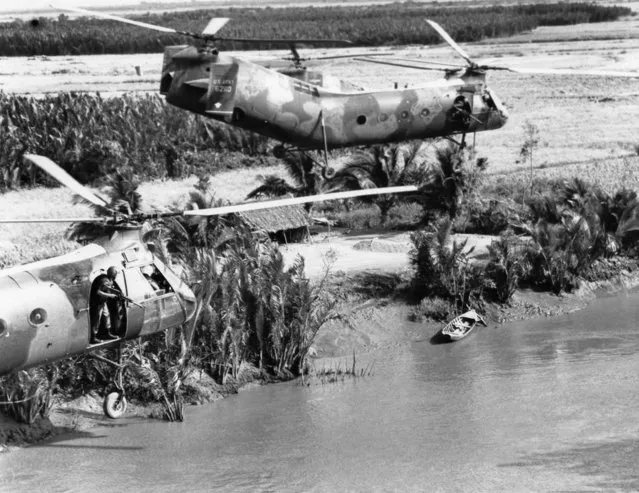
U.S. door gunners in H-21 Shawnee gunships look for a suspected Viet Cong guerrilla who ran to a foxhole from the sampan on the Mekong Delta river bank, Jan. 17, 1964. The U.S. provided air support during a South Vietnamese offensive in the Mekong Delta. (Photo by AP Photo/Horst Faas)
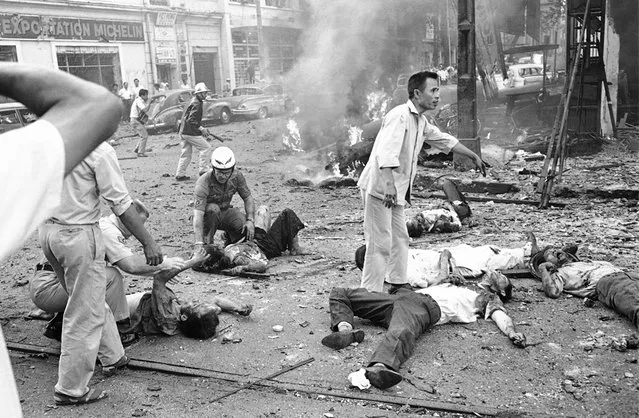
Injured Vietnamese receive aid as they lie on the street after a bomb explosion outside the U.S. Embassy in Saigon, Vietnam, March 30, 1965. Smoke rises from wreckage in background. At least two Americans and several Vietnamese were killed in the bombing. (Photo by AP Photo/Horst Faas)

Seriously injured by shrapnel grenades planted in a booby trapped Viet Cong propaganda stall, a U.S. soldier awaits evacuation from Vietnamese jungle by ambulance helicopter being summoned by a radio operator behind him on Dec. 5, 1965. The soldier was attempting to tear down a Viet Cong bamboo structure used to dispense propaganda when two M 79 grenades planted in one of the poles exploded in his face. (Photo by AP Photo/Horst Faas)
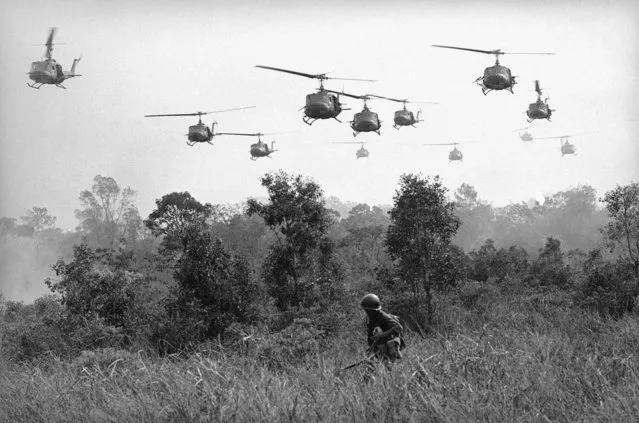
Hovering U.S. Army helicopters pour machine gun fire into tree line to cover the advance of Vietnamese ground troops in an attack on a Viet Cong camp 18 miles north of Tay Ninh on March 29, 1965, which is northwest of Saigon near the Cambodian border. Combined assault routed Viet Cong guerrilla force. (Photo by AP Photo/Horst Faas)
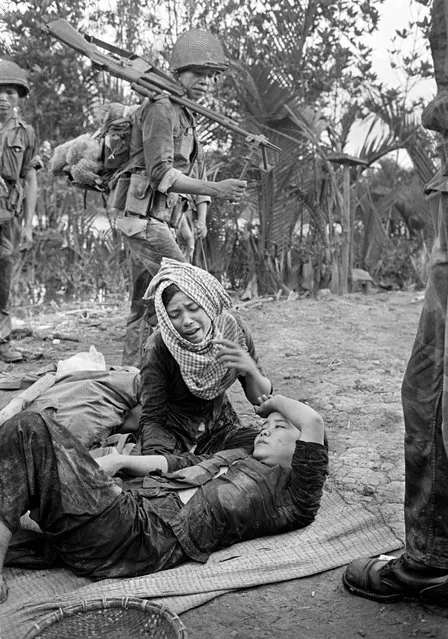
As South vietnamese troops pass by in the Ca Mau peninsula, a mother grieves over her daughter, who was badly wounded by machine gun fire from a U.S. helicopter, the week of Sept. 15, 1963. The soldiers had landed by helicopter in response to an attack by Viet Cong guerrillas on a South Vietnamese outpost. (Photo by AP Photo/Horst Faas)
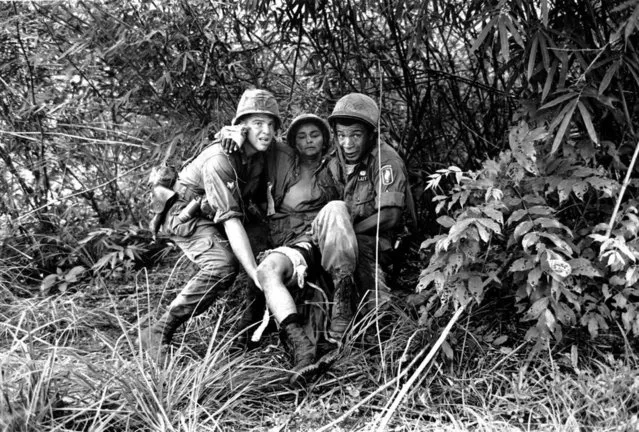
Trying to avoid intense sniper fire, two American medics carry a wounded paratrooper to an evacuation helicopter during the Vietnam War on June 24, 1965. A company of paratroopers dropped directly into a Viet Cong staging area in the jungle near Thoung Lang, Vietnam. The medics are, Gerald Levy, left, of New York; and PFC Andre G. Brown of Chicago. The wounded soldier is not identified. (Photo by AP Photo/Horst Faas)
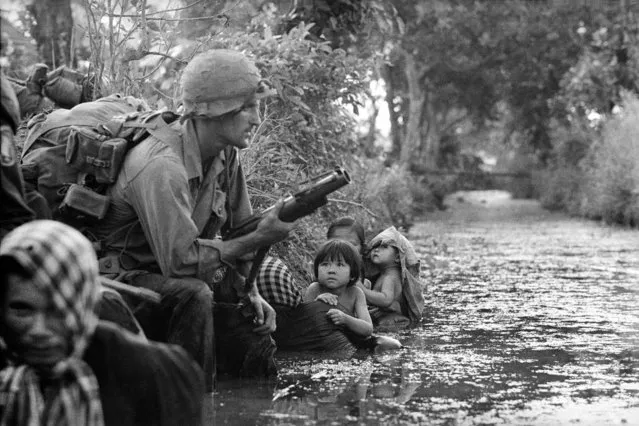
In this Jan. 1, 1966 photo, two South Vietnamese children gaze at an American paratrooper holding an M79 grenade launcher as they cling to their mothers who huddle against a canal bank for protection from Viet Cong sniper fire in the Bao Trai area, 20 miles west of Saigon, Vietnam. (Photo by AP Photo/Horst Faas)
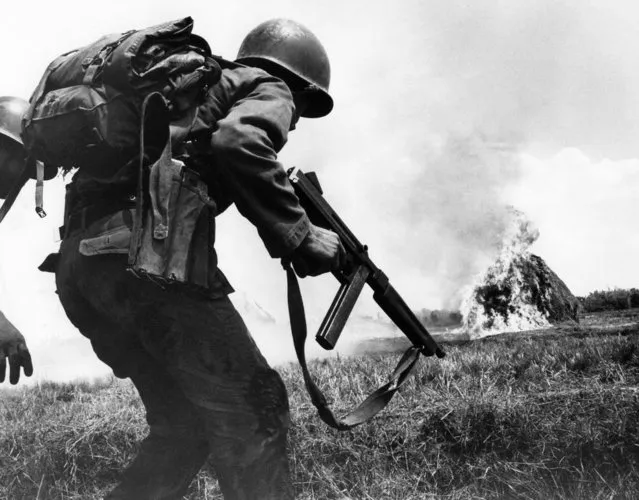
A Vietnamese infantryman jumps from the protection of a rice paddy dike for another short charge during a run and fire assault on Viet Cong Guerrillas entrenched in an area 15 miles west of Saigon on April 4, 1965. When field and surrounding brush line was finally taken, Vietnamese had suffered a loss of 12 men dead or wounded, Straw stack fire at center was set by Guerrillas as a distraction. (Photo by AP Photo/Horst Faas)
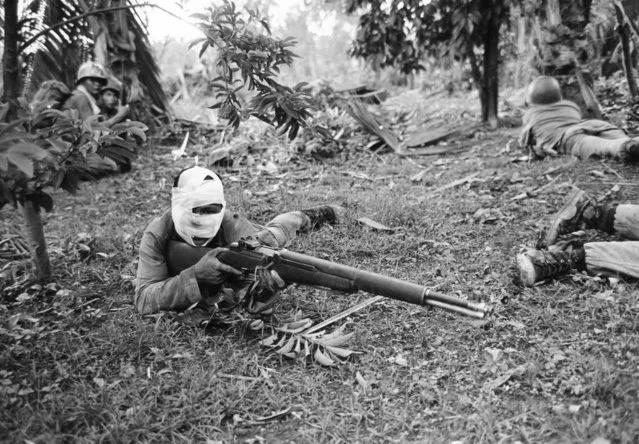
A wounded Vietnamese ranger, his head heavily bandaged with only slits for the eyes and mouth, is ready with his weapon to answer a Viet Cong attack during battle in Dong Xoai on June 11, 1965. (Photo by AP Photo/Horst Faas)
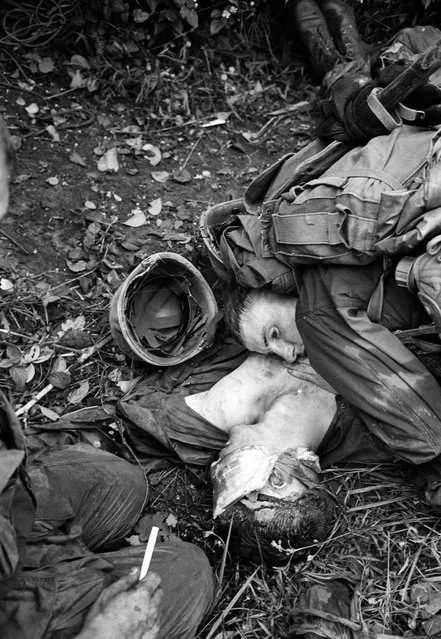
A U.S. Marine listens for the heartbeat of a dying buddy who suffered head wounds when the company's lead platoon was hit with enemy machine gun fire as they pushed through a rice paddy just short of the demilitarized zone in South Vietnam Sept. 17, 1966. (Photo by AP Photo/Horst Faas)
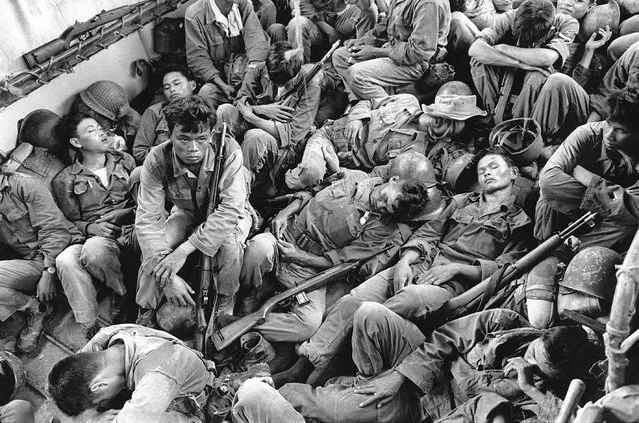
South Vietnamese government troops from the 2nd Battalion of the 36th Infantry sleep in a U.S. Navy troop carrier on their way back to the Provincial capital of Ca Mau in Aug. 1962 during the Vietnam War. The soldiers were on a four-day and night operation against the Viet Cong Communists in the swamplands of the southern tip of the country. (Photo by AP Photo/Horst Faas)

A blindfolded Viet Cong suspect and his American guard stand in the blast of a turbo jet helicopter as the prisoner waits to be removed to an interrogation site. The suspect was taken during operations on the banks of the Saigon River and through the ho bo woods in Vietnam on April 18, 1966. (Photo by AP Photo/Horst Faas)
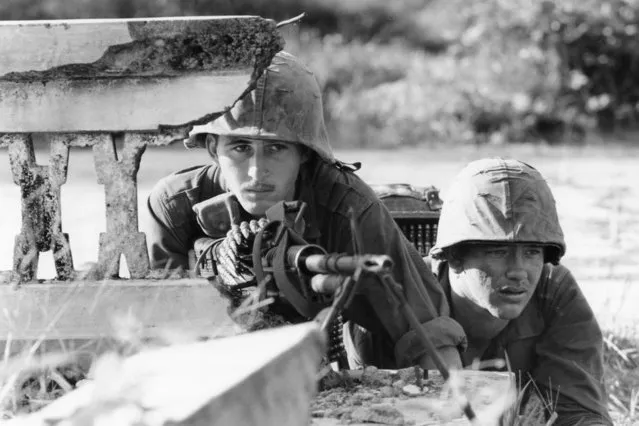
Spec. 4 James D. McClafferty of Philadelphia and Pfc. Ted Talley of Marked Tree, Ark., man a machine gun in the ruins of a house near Rach Kien, 22 miles southwest of Saigon, Jan. 2, 1966. Their company, operating in the delta province of Long An, came under fire when they approached a farmhouse at the edge of an abandoned town. (Photo by AP Photo/Horst Faas)
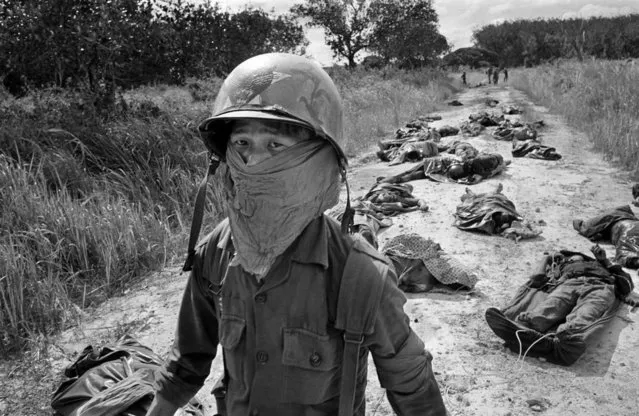
In this Nov. 27, 1965 photo, a Vietnamese litter bearer wears a face mask to keep out the smell as he passes the bodies of U.S. and Vietnamese soldiers killed in fighting against the Viet Cong at the Michelin rubber plantation, about 45 miles northeast of Saigon. (Photo by AP Photo/Horst Faas, File)
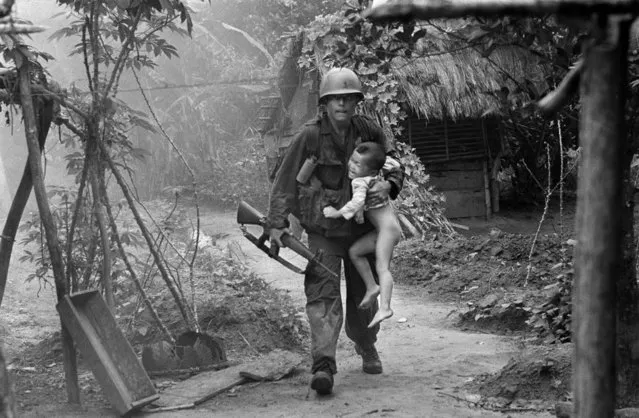
A U.S. infantryman from A Company, 1st Battalion, 16th Infantry carries a crying child from Cam Xe village after dropping a phosphorous grenade into a bunker cleared of civilians during an operation near the Michelin rubber plantation northwest of Saigon, August 22, 1966. A platoon of the 1st Infantry Division raided the village, looking for snipers that had inflicted casualties on the platoon. GIs rushed about 40 civilians out of the village before artillery bombardment ensued. (Photo by AP Photo/Horst Faas)
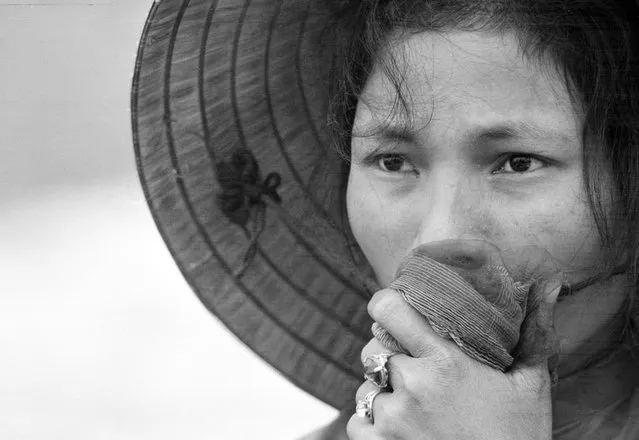
A young South Vietnamese woman covers her mouth as she stares into a mass grave where victims of a reported Viet Cong massacre were being exhumed near Dien Bai village, east of Hue, in April 1969. The woman's husband, father and brother had been missing since the Tet Offensive, and were feared to be among those killed by Communist forces. (Photo by AP Photo/Horst Faas)
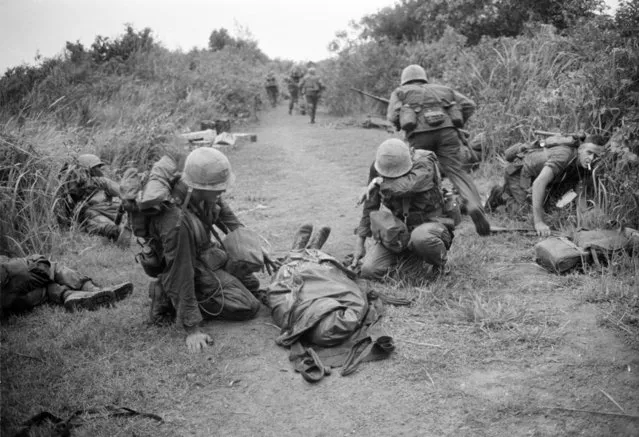
A U.S. Marine wipes tears from his face as he kneels beside a body wrapped in a poncho during a firefight near the demilitarized zone between North and South Vietnam, Sept. 18, 1966. Other casualties lie at the side of the road as fighting continued. (Photo by AP Photo/Horst Faas)
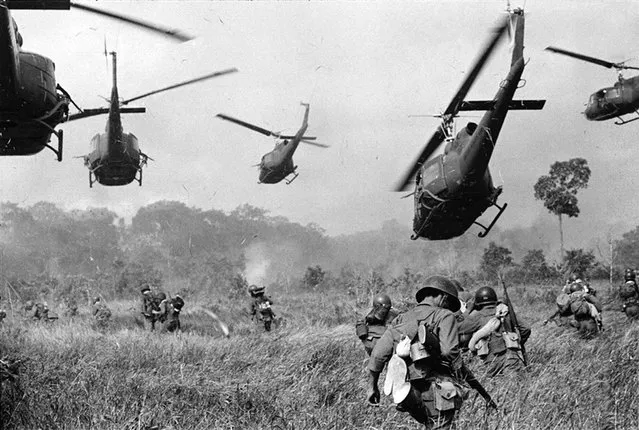
In this March 1965 photo, hovering U.S. Army helicopters pour machine gun fire into the tree line to cover the advance of South Vietnamese ground troops in an attack on a Viet Cong camp 18 miles north of Tay Ninh, Vietnam, northwest of Saigon near the Cambodian border. (Photo by AP Photo/Horst Faas)
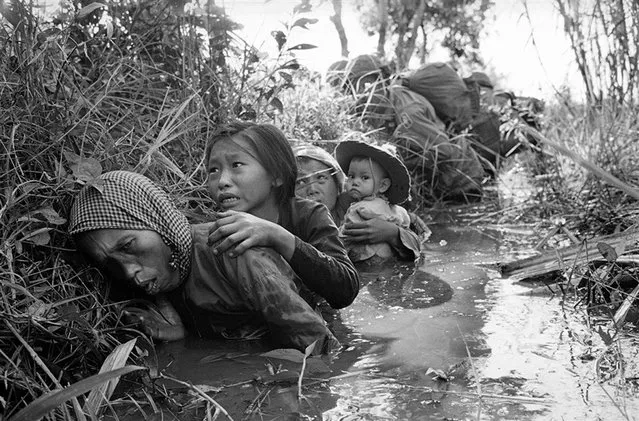
In this Jan. 1, 1966 photo, women and children crouch in a muddy canal as they take cover from intense Viet Cong fire at Bao Trai, about 20 miles west of Saigon, Vietnam. (Photo by AP Photo/Horst Faas)
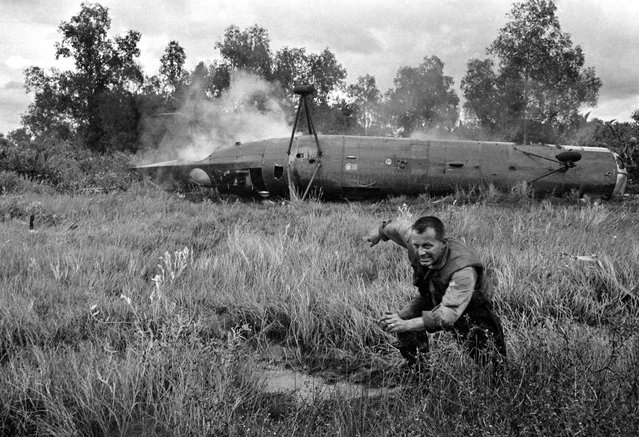
A U.S. crewman runs from a crashed CH-21 Shawnee troop helicopter near the village of Ca Mau in the southern tip of South Vietnam, Dec. 11, 1962. Two helicopters crashed without serious injuries during a government raid on the Viet Cong-infiltrated area. Both helicopters were destroyed to keep them out of enemy hands. (Photo by AP Photo/Horst Faas)
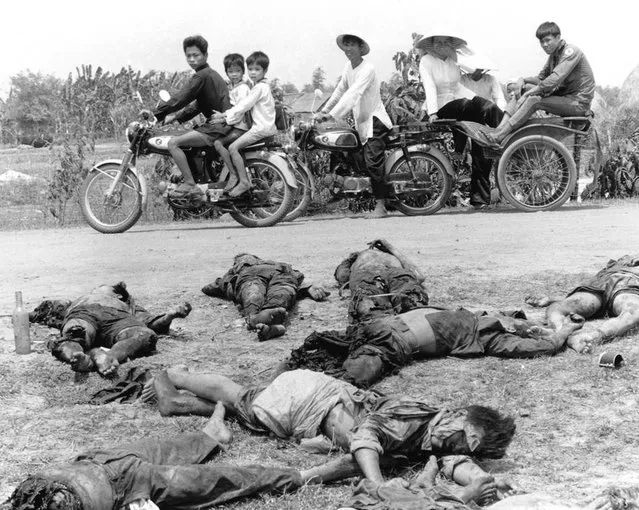
Children ride home from school past the bodies of 15 dead Viet Cong soldiers and their commander in the village of An Ninh in Vietnam's Hau Nghia province on May 8, 1972. (Photo by AP Photo/Horst Faas)
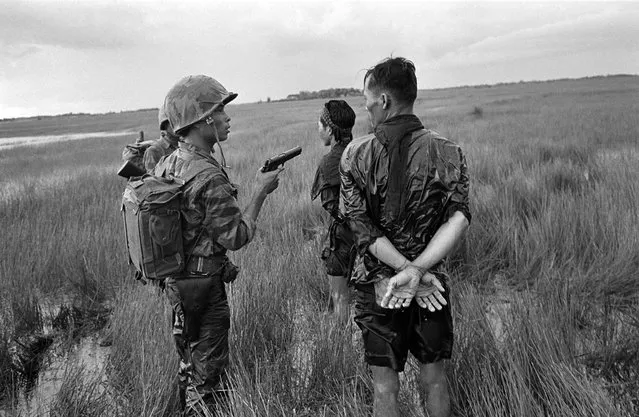
A South Vietnamese soldier holds a cocked pistol as he questions two suspected Viet Cong guerrillas captured in a weed-filled marsh in the southern delta region late in August 1962. The prisoners were searched, bound and questioned before being marched off to join other detainees. (Photo by AP Photo/Horst Faas)
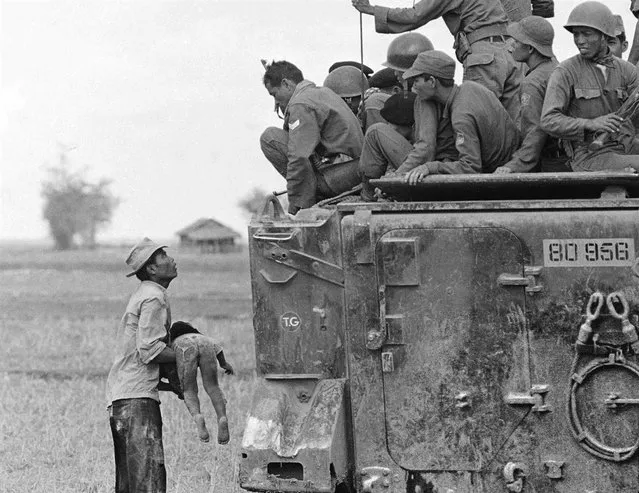
In this March 19, 1964 photo, one of several shot by Associated Press photographer Horst Faas which earned him the first of two Pulitzer Prizes, a father holds the body of his child as South Vietnamese Army Rangers look down from their armored vehicle. The child was killed as government forces pursued guerrillas into a village near the Cambodian border. (Photo by AP Photo/Horst Faas)

In this 1967 photo, Associated Press photographer Horst Faas works in Vietnam. Faas, a prize-winning combat photographer who carved out new standards for covering war with a camera and became one of the world's legendary photojournalists in nearly half a century with The Associated Press, died May 10, 2012. He was 79. (Photo by AP Photo)
24 May 2012 09:43:00,
post received
0 comments
